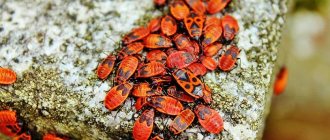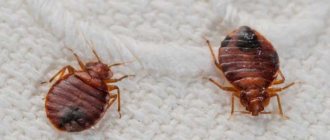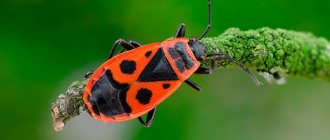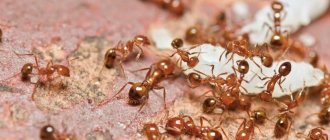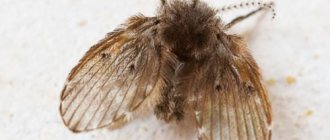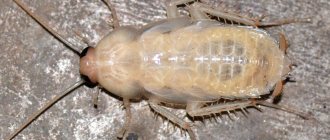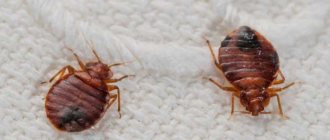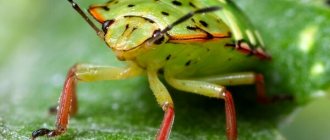Appearance of a bug
You can see what street bugs look like in the photo below. They have a flattened body resembling an irregular pentagon, a proboscis and six legs. In our article you can read about the habits and characteristics of the insect.
It is not difficult to recognize the forest bug among its other relatives. Its body has a characteristic shape, wide and dense and of a certain color.
There are several known species of these insects, and each color is quite original. On the Internet you can find many interesting photos of representatives of different types of forest bugs.
The green wood bug usually lives in Russia. The insect has the unique ability to change its color. In spring it is disguised as the first leaves and therefore has a light green color. In summer, brown spots appear on the chitinous shell. Towards the end of autumn, a brown tree beetle appears in the forest and blends in with the fallen leaves. This allows him to become invisible and protect himself from enemies.
Insects can travel considerable distances, although they rarely need to fly. Long antennae are located on the head of the beetle and smell glands are located on the chest.
Important! All types of forest bugs have a characteristic, very unpleasant odor.
Damage caused
When describing the negative impact of bedbugs, it should be noted that all species of these insects have a piercing-sucking apparatus.
The process of food absorption is carried out by piercing the leaves and stems of various types of plants and absorbing juice from them. Note that such bites cannot cause significant harm to tree foliage; it’s another matter if insects decide to attack cereal crops at home, in which case the damage can be immeasurable. However, this behavior of insects is extremely rare.
This type of beetle is very selective about its diet. The bushes of raspberry, elderberry and cherry trees are of great interest to them. A favorite delicacy of pests is spoilage of an unopened flower bud or tree bud.
Many novice gardeners wonder if insects bite? This is impossible; the only thing a bedbug can do is give off an unpleasant odor in case of danger. The protective reflex mechanism is provided by his odorous glands, they are located on the chest between his legs. This “aroma” includes a number of aldehydes with an admixture of cimicic acid, which enhances the harshness. It is worth noting that in some cases such a smell can lead to the death of certain insects; it does not pose any danger to humans.
The worst thing is when a “stink bug” takes up residence in your garden plot. This especially applies to fruit bushes growing in your area. So, during the breeding season or when frightened, these beetles are capable of causing significant damage to raspberry and currant bushes, which manifests itself in a decrease in plant productivity.
Habitat
Forest bugs are ideally camouflaged to match the color of foliage or tree bark, so in nature you can find individuals whose color varies from pale green to brown. Forest bugs primarily inhabit forests and their surroundings. With the onset of cold weather, they hibernate and spend the winter under fallen leaves or hiding under the bark of old trees.
Woodbugs love to live in an atmosphere where the ideal temperature and humidity are maintained. When the situation changes and there is severe cooling, warming or humidity fluctuates greatly, insects begin to wander and can find comfortable conditions in a person's apartment.
How to recognize a forest bug, photo
The forest bug is arboreal and has a light green tint. Thanks to its chitinous cover, the stink bug easily and reliably hides among the foliage from enemies, so it will be difficult to see it. In autumn, the leaves turn brown, and with them the shell of the insect becomes brown, giving the stink bug the opportunity to camouflage itself until it goes into hibernation.
If you look at photos of bedbugs at different times of the year, you can see that they really change color depending on the time of year.
Signs of appearance
Leaving their usual habitat, forest bugs can appear in a person’s home. This mainly occurs at the end of summer, when temperature conditions and humidity can change dramatically. In search of a pleasant environment, insects rush closer to humans.
Street bugs rarely end up in an apartment, because they are not human parasites and can only enter the house by accident. This usually happens when forests - their natural habitat - become too wet or vice versa when forest fires occur.
These smelly forest dwellers may only scare people with their unattractive appearance, but they are harmless.
If you find a stink bug in your home, you must act immediately. A female can lay up to 100 eggs, so you need to start fighting before the bed bugs multiply. Stink bugs are not a sign of lack of cleanliness and do not cause damage - so be calm and gentle in the fight!
Which of the bugs living in the forest get into the house?
Bedbugs that live in and around forests, as already mentioned, rarely get into houses. And very few people end up in city apartments. People often confuse forest dwellers with shield insects, which parasitize only in gardens and vegetable gardens.
In order not to mistake an ordinary stink bug (raspberry bug) for a forest bug, you should know that the forest inhabitant has:
- The body is painted in a brighter shade;
- There is almost no unpleasant odor, even if the insect is crushed.
Most often, people confuse forest bugs with:
- Shields are two-toothed, in which the body has a brown tint, and there are small growths in the back area; catch small caterpillars;
- Red-footed stink bugs, whose bodies resemble aged bronze in color, and the maximum size to which insects can grow is 1.5 cm;
- American bugs, which live in forests, eat cones; this species appeared on the territory of our country not so long ago.
Don't kill street bugs
To remove the insect, you have several options. It is important, first of all, that you take the six-legged animal safely outside. If you crush or kill them, they will start to stink and you will have to live in a foul-smelling apartment for days.
- Use paper first
You can use a broom to move the insect onto a sheet of paper and then release it into nature.
- With a vacuum cleaner
Alternatively, you can also use a vacuum cleaner. To protect your device from the evil smell of six-legged creatures, use the following trick: attach a stocking or the end of pantyhose to the vacuum cleaner pipe and suck the beetle at the lowest level. Then you can release the intruder from the stocking to freedom.
- Proprietary bug spray
Instead of buying chemical bug spray, you can make your own. Simply mix 120ml vinegar, 60ml dish soap and 250ml hot water and place in a spray bottle.
Clove oil, ammonia, and juniper can help drive out invaders with their strong scent.
You can prevent intrusion with simple techniques:
- Spray or wipe window and door frames with vinegar, the smell will keep insects away.
- Check your attic, through which six-legged criminals can enter your home. Seal the cracks with silicone or sealant.
- Intruders are attracted to light, so you need to minimize lighting outside your home.
- Place sticky traps on your windowsills so you can catch the bugs before they get into your home.
Reproduction
After hibernation (April-May), insects move to places where they have enough food. It will not be difficult to determine what forest bugs feed on, since their accumulation is greatest in places where young trees and the first green spaces grow. Their main product is vegetable juice.
The new offspring of insects are in close proximity to forest restaurants. Under favorable temperature conditions, the female can lay eggs twice a season on the inside of the leaves.
The forest beetle reproduces without leaving its feeding area. The female lays hundreds of eggs on the leaves and stems of plants and holds them so that each egg is difficult to remove with a fingernail.
The development of the egg takes about 10 days, after which the larva emerges, which is similar in appearance to the adult, but has a smaller size and a slightly different color.
The transformation of the larva into an adult takes about 30 days. During this time, the future forest green beetle will have time to shed several skins. The larva goes through five stages in its development. An adult insect has a body length of about 15 mm.
The reasons why shieldworms want to get into the apartment?
Forest bugs differ from other species of bugs in that they live in the most optimal conditions for themselves. They like it when the air temperature does not exceed the values that are acceptable for them, and the air humidity corresponds to certain parameters. As long as everything is normal, insects will not leave the forest.
But if some changes occur, for example, a fire breaks out, then they leave their place and go in search of another place suitable for their habitat.
When a flying bug from the forest appears in an apartment, many complain about the difficulty of getting rid of it. And although the insect poses absolutely no threat to people, nevertheless, people experience negative emotions from meeting it.
Unless you just need to carefully examine your house plants, and if you find a clutch of eggs on their leaves, it is recommended to remove them immediately to prevent the death of the plant and the appearance of a colony of bedbugs in the apartment.
Harm or benefit of a bug
In fact, bedbugs are harmless to people, except for bed burglars who feed on the blood of animals and people. Wood bugs bite people much less often than bed bugs, but they are dangerous because they transmit serious diseases.
Harm
Forest bugs can really cause harm when they settle en masse on ornamental, garden or food crops.
Bugs in the forest, with an unpleasant odor and ugly appearance, do not harm anyone. But among them there are varieties that can attack farmland and cause significant damage. They inject poison into the sprouts, which leads to the death of young shoots.
Insects may also appear in the garden. The reason for this invasion is a strong drop in temperature or forest fires, so hordes of insects move into gardens in search of food. The most common targets of attack are raspberries and gooseberries. Forest bugs not only destroy raspberries, they also leave a smell on the berries, which they also sometimes eat.
Benefit
However, there are also very useful predatory bugs that destroy many harmful insects. These include Antocoris and other bugs belonging to the same family. They suck out aphids, mites, small caterpillars, and egg laying of many pests.
There are even bugs with which they try to fight the Colorado potato beetle, for example the perillus bug (unfortunately, it is very heat-loving).
Predatory bugs are usually distinguished by greater mobility than herbivorous species and always have a “slender”, elongated body with long legs.
FUN!
There is no benefit from the insect. But there is one recipe that can be used wisely. The raspberry beetle is used in folk medicine to produce vodka tincture for alcoholism. The bitter taste of the drug and intolerance to the smell causes disgust and rejection of alcoholic beverages, which discouraged drunkards from their destructive illness.
How can insecticides affect the human body?
Those mechanisms in the bodies of bed bugs that are affected by insecticides are generally identical for both insects and humans.
For example, most drugs for bedbugs disrupt the mechanism of impulse transmission in nervous tissue. It is due to this action that they lead to paralysis in bedbugs and their death.
Nervous tissue in humans is generally structured in the same way as in insects. Therefore, one might assume that bedbug remedies should also lead to paralysis in humans.
However, this does not happen even in cases where, for some reason, a significant amount of insectoacaricide enters the human body. This is due to the fact that in bedbugs and other insects - cockroaches, for example, or fleas, the final effect on the nervous tissue is not the substance that is in the spray bottle, but its derivatives, into which the original insecticide is converted under the influence of various enzymes in the insect body. That is, the insecticide enters the body of the bug, where it is transformed into another substance in the hemolymph, sometimes in the nervous tissue it turns into another, and the final product of such transformations acts on nerve receptors, or synapses, or on neuroglia.
But in the human body such transformations do not occur due to a different set of enzymes and a generally different environment into which the insecticide enters. It’s commonplace that in a bug the toxic substance enters the hemolymph, and in a person it either enters the digestive juice in the stomach or the blood from the lungs. And the compositions of hemolymph, blood and gastric juice are completely different. And the process that takes place in the hemolymph of a bug will not start in human blood.
The simplest example: let’s take malathion (its other name, better known, is karbofos). Once in the body of a bug, it turns into malaoxon on its way to the nervous tissue, which is much more active and toxic to the insect. It is malaoxon that poisons the insect. But in the body of warm-blooded animals, including humans, dogs or cats, malathion is either not converted into malaoxone at all, or is converted slowly, in very small quantities, and the final malaoxone is hydrolyzed much faster. As a result, malathion specifically does not have the same neuroparalytic effect on people as on bedbugs.
The situation is approximately similar with other insecticides. Some do not transform into highly toxic substances, while others do, but very slowly. Only a few of them affect people in the same way as they do insects.
But at the same time, almost all insecticides in large quantities are toxic to humans. It doesn’t matter whether they act on the human body in the same way as on the body of a bug, or lead to poisoning through a different mechanism, but they have a toxic effect. Therefore, if you drink a liter of Karbofos, you can be seriously poisoned, and if you inhale an aerosol with lambda-cyhalothrin, you can suffocate.
Most insecticides can cause an allergic reaction upon contact with the skin, or irritation and itching upon contact with mucous membranes (for example, in the eyes). However, the likelihood of such an allergy in an individual person is the same as when working, for example, with household detergents or food products. That is, insecticides are no more allergenic than toilet gel or natural spices.
All this means that in fact the danger lies not in the product, but in its quantity. We remember that in certain quantities a medicine can turn into poison. And in some quantities the insecticide is harmless, but in large quantities it is already dangerous.
All this is relevant for insecticides that are used in the form of a liquid solution. Moreover, their danger manifests itself only in such a liquid state. When these solutions dry on surfaces, they do not pose a danger to humans even if they accidentally come into contact with such a treated surface.
That is why properly produced insecticides for home use contain such concentrations of active substances that will lead to the destruction of bedbugs, but will not allow them to poison a person even if there are occasional minor errors in their use on the part of an inexperienced handler. At the same time, as we remember, the means vary in their danger to humans. And among them there are those that need to be used very carefully, and there are those that even with a strong desire cannot be poisoned.
Therefore, for clarity, you need to understand the danger or safety of the most common household means for killing bedbugs.
Should you be afraid of a forest bug bite?
The bite of a forest beetle does not pose any danger, especially since these insects are not at all inclined to bite humans. Many people confuse these insects with mites, but this is completely incorrect: mites are warm-blooded parasites (and their bite can cause health problems), while forest bugs parasitize plants. Diseases are carried only by tropical bugs.
Of course, there are bedbugs whose bite can be very painful and unpleasant. These rather large predators (up to 2 cm), feeding on small invertebrates, have a long, piercing proboscis, with which they hunt spiders, imitating the prey being caught in a web. The bite of a predator is painful, but predators themselves rarely enter a human home, and cases of their bites are rare.
What kind of forest bugs are often found in the house?
The forest bug can be seen not only in the forest, grove or park area, but even at home. However, as a rule, apartments are not attractive to these insects; they fly there and into residential buildings by accident. In the private sector or cottages, these hemiptera are found more often, since there is an abundance of vegetation nearby. By mistake, the forest bug is mistaken for a tree stink bug, which is capable of causing damage to agricultural plantings when the population increases in one area.
The shield bug has a brighter color than its forest “brother”. In addition, when touched, it emits a sharp and unpleasant odor, for which it received the name “stink bug.”
It happens that other types of bugs are mistaken for forest bugs. These include the following:
- red-legged stink bug - it is characterized by a color that resembles old bronze in appearance, the size of the body reaches 16 mm;
- The two-toothed stink bug is a brown or brown-colored insect, its distinctive feature is pointed protrusions near the head, more like the forearms of armor; The individual feeds mainly on caterpillars;
- The American bug is an inhabitant of the forest; its favorite delicacy is young cones (often they begin to rot and dry out after attacks by the insect).
Why do forest bugs fly into human homes?
Forest bugs are demanding of environmental conditions: they need a certain temperature and humidity for successful life and reproduction. If insects no longer feel comfortable in their chosen territory, they begin to move around in space. This can happen during a sudden thaw, cold snap, or fires. It is at these moments that bedbugs are found in a person’s apartments or houses.
Reviews
“I constantly find some bugs in my room, the description is similar to forest bugs. I read that they are harmless to humans and do not bite. Neighbors also said that they saw the same insects in the apartment. Every day I collect 5-6 pieces and throw them out into the street, but they appear again.”
Svetlana, Orekhovo-Borisovo
“There are a lot of trees around my house, and one of them - large and spreading - is located right under my window. In the apartment I often see small and large forest bugs. In our region, their numbers have increased greatly, which is noted by other residents, my neighbors and acquaintances. And with this tree I have only one torment, because it is an open path for insects to my home. Insecticidal aerosols do not help cope with the problem.”
Maria, Vladivostok
Forest bugs do not bite people, and if this happens as an exception, then the bite is harmless. These insects should not be confused with ticks that hunt warm-blooded victims.
Too large a family of forest bugs can negatively affect the condition of ornamental, garden and berry crops. Parasites, like tree insects, live on the leaves and stems of plants, feeding on their juices.
Who can be confused with
In central Russia there are many varieties: the berry bug, which damages the leaves and fruits of various berry crops, and the meadow bug, which lives on herbaceous vegetation and ornamental crops.
There are different types of cruciferous bugs: the cabbage bug, which damages cabbage, radishes, turnips, etc. Pests include the sorrel bug, some lace bugs, and the pear bug.
There are bedbugs that can cause harm only occasionally. These are soldier bugs that prefer fallen seeds and fruits, organic debris and dead insects, but sometimes damage seedlings of garden crops.
Stink bugs should not be confused with their smaller cousins, bed bugs. A telltale sign of a bed bug infestation is small black spots on wallpaper or bed frames because the animals have left their excrement there.
Forest bugs on the site
But if forest bugs have settled in a vegetable garden or garden, then you will need to take some measures to drive them out. Only you should forget about chemical insecticides, since when they treat plants, the poison contained in them will settle on the leaves and fruits, and if consumed as food, a person will harm his health.
It is better to take a closer look at folk remedies - they are effective and will not harm your health.
Bed bugs are known to hate the smell of onions. You can prepare a special infusion: take a large bag of onions, fill it with cold water (1 bucket), leave for 5 days to infuse, strain. Use the infusion to spray on garden plants. The treated plants will not be touched by bugs.
Mustard is another effective remedy against bedbugs. Pour the dry powder into 10 liters of prepared water, mix well and that’s it, you can use it immediately.
Massive insect infestations occur very rarely and, unfortunately, folk remedies alone cannot cope with them. Something stronger will be needed.
Bedbugs are afraid of burnt wood, or rather its smell. You can try to protect your area from bedbugs with simple ash, scattering it in a thick layer and a wide strip along the entire perimeter of the garden. If it suddenly starts to rain, then after it stops, sprinkle the area again.
How to get rid of forest bugs - the harm of forest bugs
Experts advise against using strong chemicals or killing insects. Even if you observe excessive activity of these insects and they are literally “confiscating” your home, it is better to simply try to prevent their invasion.
This can be done using a regular mosquito net. The forest guest is quite large and cannot pass this reliable barrier.
As a rule, infestations of forest bugs in the city are temporary, and the insects soon return to their usual habitats. Don't worry about wood bugs in your home. This plant pest is absolutely safe for humans.
To fight forest beetles, it is advisable to simply collect them in a pile and throw them out the window.
Alternatively, dissolve two bars of soap in ten liters of water and treat garden fruit.
As a precaution, it is necessary to collect and destroy all fallen leaves on the site so as not to leave the forest bug a comfortable shelter for wintering.
Products and chemicals
When bedbugs are found in your home, experts do not recommend using strong chemicals or calling a special service to get rid of them. Insects do not settle forever in a city apartment. They soon return to their natural habitat. Once you find a forest dweller, simply throw it out the window. Insects are not dangerous, but they can interfere with the usual way of life and sometimes harm indoor plants.
Fighting forest bugs in the garden
If all measures do not give the desired result and forest bugs continue to cause damage to berry and vegetable crops, you can resort to extreme measures, the use of chemicals.
The most effective in this case are:
- chlorophos;
- dichlorvos;
- phosphamide
All these products can be purchased in stores. Destruction must be carried out using personal protective equipment.
Traditional methods
There are many different ways to solve the problem of how to get rid of forest bugs that have settled in the garden or are in a city apartment. They are much easier to deal with than bed bugs. It is advisable to start exterminating insects in the garden with popular recipes that will successfully solve the problem.
You can proceed as follows:
- Try collecting all adult parasites by hand and removing their larvae from the leaves;
- Prepare an infusion based on onion peel or mustard powder and spray the plants 2-3 times a day.
- You can plant a cohosh plant (a perennial of the ranunculaceae family), popularly referred to as “black cohosh.”
Forest bug - how is it harmful?
The main harm from forest bugs is their rapid and active reproduction. For humans themselves, as mentioned above, these insects are not harmful, but for agriculture - yes. And although some stink bugs destroy pest caterpillars, their larvae also eat plants and berries, which means they are not welcome in vegetable gardens and garden plots. For example, if there are a lot of bugs on one tree, then they will definitely lay a lot of eggs, and their offspring will gradually bring the tree to such a state that it will not be able to bear fruit. Therefore, it will be necessary to take measures to reduce the number of these insects, but it is still not recommended to completely eliminate them.
The presence of bedbugs on a bush or tree can be detected as follows: conduct a thorough inspection of the foliage for greenish eggs. You just need to look very carefully, because it is quite difficult to see eggs of the same color on green leaves.
Of course, stink bugs are not the most dangerous pests in garden plots, but if their number has already become huge, you need to purchase an insecticide and treat the places where insects are most localized with it.
Modern experts have set out to develop special varieties of plants that are not suitable for eating by stink bugs. And they control the number of bedbugs using pesticides.
Prevention
To get rid of stink bugs, you don't have to kill them. When beetles feel threatened or die, they release their smelly secretions.
The best tips for fighting forest bugs:
- Mosquito screens on windows and doors are most effective against stink bugs.
- Just don't keep windows and doors open in the summer.
- Since insects are attracted to heat and light, especially in the evening, do not ventilate with the lights on. This procedure is also suitable for other troublemakers such as moths and flies.
- As soon as the forest guest has entered the home, he can and should be caught and released again outside. This is best done with a glass and a piece of paper or cardboard.
- The use of toxic insecticides is not recommended. They harm not only insects, but possibly also their own health, especially in enclosed spaces.
